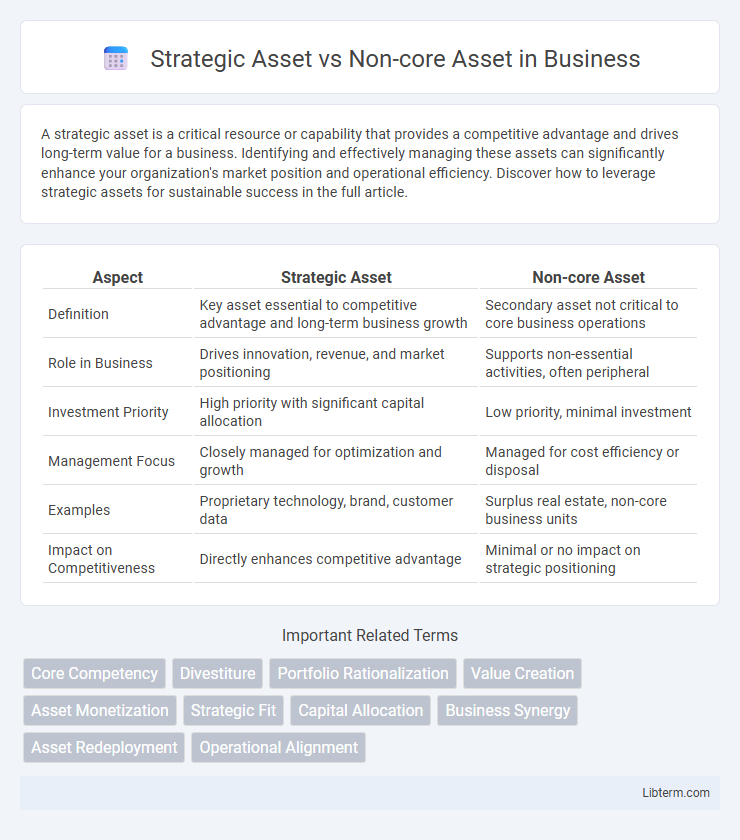A strategic asset is a critical resource or capability that provides a competitive advantage and drives long-term value for a business. Identifying and effectively managing these assets can significantly enhance your organization's market position and operational efficiency. Discover how to leverage strategic assets for sustainable success in the full article.
Table of Comparison
| Aspect | Strategic Asset | Non-core Asset |
|---|---|---|
| Definition | Key asset essential to competitive advantage and long-term business growth | Secondary asset not critical to core business operations |
| Role in Business | Drives innovation, revenue, and market positioning | Supports non-essential activities, often peripheral |
| Investment Priority | High priority with significant capital allocation | Low priority, minimal investment |
| Management Focus | Closely managed for optimization and growth | Managed for cost efficiency or disposal |
| Examples | Proprietary technology, brand, customer data | Surplus real estate, non-core business units |
| Impact on Competitiveness | Directly enhances competitive advantage | Minimal or no impact on strategic positioning |
Understanding Strategic Assets: Definition and Importance
Strategic assets are critical resources or capabilities essential for a company's competitive advantage and long-term success, such as proprietary technology, brand reputation, or key intellectual property. These assets enable organizations to create value, differentiate from competitors, and sustain market leadership. Understanding strategic assets helps firms allocate resources effectively, prioritize investments, and safeguard core competencies crucial for business growth.
What Are Non-core Assets? Key Characteristics
Non-core assets are company holdings not essential to its primary business operations, often including subsidiaries, real estate, or equipment that do not directly contribute to core revenue streams. These assets typically exhibit characteristics such as lower strategic value, limited impact on competitive advantage, and potential liquidity for divestment opportunities. Identifying non-core assets enables firms to optimize portfolios, reallocate resources efficiently, and focus on growth-driving core activities.
Strategic vs Non-core Assets: Main Differences
Strategic assets are critical components that directly contribute to a company's competitive advantage and long-term growth, often including core technologies, key intellectual property, and essential operational capabilities. Non-core assets are peripheral resources that do not drive primary business objectives and can be divested without significant impact, such as surplus real estate or non-essential subsidiaries. The main differences lie in their impact on strategic goals, value creation, and priority in management decisions.
The Role of Strategic Assets in Business Growth
Strategic assets such as patented technologies, brand reputation, and proprietary processes drive business growth by creating competitive advantages and enabling market differentiation. These assets generate long-term value through increased revenue, improved operational efficiency, and enhanced customer loyalty. In contrast, non-core assets, which are not essential to the primary business operations, typically have limited impact on growth and are often divested to free resources for strategic investments.
Identifying Non-core Assets within Your Organization
Identifying non-core assets within your organization involves analyzing resources that do not directly contribute to your primary business objectives or competitive advantage, such as underutilized property, outdated technology, or peripheral business units. These assets often incur maintenance costs without generating proportional value, making them prime candidates for divestiture or repurposing to improve operational efficiency. Strategic asset allocation reserves capital and management focus for core capabilities, enhancing overall financial performance and market positioning.
Criteria for Classifying Assets: Strategic or Non-core
Criteria for classifying assets as strategic or non-core hinge on their impact on long-term competitive advantage, revenue generation, and alignment with the core business mission. Strategic assets typically contribute critical capabilities, market positioning, or essential resources, whereas non-core assets are often peripheral, easily divested, or non-essential to primary operations. Evaluating factors such as asset uniqueness, potential to drive sustainable growth, and relevance to key strategic objectives determines their categorization for focused investment or divestiture.
The Impact of Strategic Assets on Competitive Advantage
Strategic assets, such as proprietary technology, strong brand equity, and exclusive intellectual property, serve as critical drivers of sustained competitive advantage by enabling firms to differentiate their offerings and create barriers to entry. Unlike non-core assets, which can be divested without significant impact, strategic assets are deeply embedded in organizational capabilities, directly influencing innovation, market positioning, and customer loyalty. The effective management and leveraging of these assets result in superior performance and long-term value creation in competitive markets.
Optimizing Portfolio: Divesting Non-core Assets
Divesting non-core assets enhances portfolio optimization by reallocating capital to strategic assets that drive long-term growth and competitive advantage. Prioritizing strategic assets ensures focused resource deployment, operational efficiency, and improved return on investment. This approach strengthens core business capabilities while reducing distractions from less critical or underperforming segments.
Case Studies: Strategic Asset Management Success Stories
Strategic asset management has driven transformational growth in companies like General Electric, where focused investment in core industrial assets enabled market leadership and technological innovation. Case studies from the energy sector highlight how firms divesting non-core assets redirected capital to high-return projects, enhancing operational efficiency and shareholder value. These success stories underscore the importance of prioritizing strategic assets to sustain competitive advantage and long-term profitability.
Best Practices for Managing Strategic and Non-core Assets
Effective management of strategic assets involves prioritizing long-term value creation, aligning resources with core business objectives, and conducting regular performance evaluations to maximize competitive advantage. Non-core assets require periodic assessment to determine divestiture opportunities, cost reduction strategies, or potential redeployment to support strategic initiatives. Implementing clear governance frameworks and leveraging data-driven decision-making enhances asset portfolio optimization and overall organizational agility.
Strategic Asset Infographic

 libterm.com
libterm.com